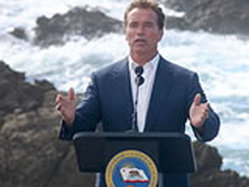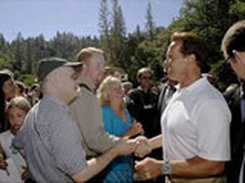ARNOLD SCHWARZENEGGER
California's 38th Governor
Arnold Schwarzenegger was sworn in as the 38th Governor of California on November 17, 2003. His landslide election as the state's chief executive follows a distinguished career in business and entertainment.
Governor Schwarzenegger's top priority is fulfilling his mandate from Californians to bring jobs back to the state and restore its prosperity. Upon taking office, he inherited an unprecedented fiscal crisis. He averted bankruptcy with measures that refinanced old debt and required the state to live within its means without raising taxes. Schwarzenegger's workers' compensation reform package repaired a system that had the highest costs in the nation and his Indian Gaming Compacts secured California's fair share of billions of dollars in revenue. In 2004, he signed legislation to prevent "shakedown" lawsuits which were driving jobs and businesses out of California and blocking its path to recovery.
Governor Schwarzenegger's firm belief that economic prosperity and environmental health go hand in hand was evident during his first year in office. His Oceans Action Plan will set a national standard for the management of ocean and coastal resources. He created California's Hydrogen Highway by Executive Order to support the transition to a clean hydrogen transportation economy. The Governor also signed historic legislation creating the 25-million acre Sierra Nevada Conservancy, California's largest.
Throughout his career, he has had a strong commitment to children. Before becoming governor, Schwarzenegger founded the Inner City Games Foundation and pushed for more funding for after school programs. He championed the After School Education and Safety Act of 2002 (Proposition 49), overwhelmingly approved by voters. As governor, he is taking action to give California's children the quality education and opportunities they deserve. His settlement of the landmark Williams vs. California lawsuit contained reforms that ensure qualified teachers for every student and clean and safe school facilities with up-to-date textbooks. He has increased per pupil spending and education funding and worked hard to give local schools the power to meet the specific needs of their own communities.
Governor's Projects
Governor Schwarzenegger on Thursday visited Thiara Brothers Orchards in Merced to highlight California's heat illness prevention standards, which take permanent effect today. He spoke to employers about their obligation to comply with these standards, and educate workers about their rights and responsibilities when working outdoors.
The Governor pioneered the state and nation's first standards to keep outdoor workers safe from heat illness.
•Summer fatalities in California's construction and agricultural industries prompted Governor Schwarzenegger to collaborate with the state legislature, labor and agricultural leaders- including United Farm Workers, the Western Growers Association, California Grape & Tree Fruit League and the Nisei Farmers League-to debut the country's first emergency standards to prevent heat illness in August 2005.
•Stakeholders had debated these standards for more than 15 years; success was due to Governor Schwarzenegger's commitment to resolving this issue with all parties.
•With the Governor's urging and support, Cal/OSHA's Standards Board adopted the standards as permanent in June 2006. They were subsequently approved by the Office of Administrative Law and take effect statewide today.
Protecting outdoor workers from heat illness helps save lives and maintains productivity. The Governor urges every employer and all outdoor workers to follow these critical measures.
•The Governor's heat stress standards affect all Californians who work outdoors, including construction workers, highway and farm workers, landscapers and others.
◦The protections require that:
■Supervisors and workers are trained to recognize, prevent and treat heat illness.
■Employers put their training program in writing and make it available to employees.
■Employers follow current laws and make one quart of water per person per hour available to every outdoor worker at all times.
■Workers have access to a shaded area for no less than five minutes any time they are suffering from heat illness or need a place to cool down to keep themselves from becoming sick.
Yesterday Governor Schwarzenegger directed state agencies to protect vulnerable Californians from the current heat wave.
•The Department of Consumer Affairs was directed to turn its existing call centers into information lines where Californians can find the cooling center nearest to their homes.
◦Call 1-800-952-5210 to find cooling centers in your community.
•The California Department of Health and Human Services was directed to make sure all nursing home and residential care facilities are prepared for high temperatures and have evacuation plans.
•The Department of Social Services was directed to contact every county public health officer in heat-affected areas and every county welfare director to conduct on-site visits to all single room occupancy hotels.
•Governor Schwarzenegger also instructed state-owned fair grounds to operate as "cool centers," in-home support service personnel to check on vulnerable clients and every Californian to make sure their elderly, disabled or at-risk neighbors are safe.
California's heat wave makes everyone vulnerable to heat illness. Prevention is key to safety.
•While heat illness can be fatal, it is also preventable. Cramps, exhaustion, fainting, dizziness and disorientation are all symptoms of heat illness. Californians can protect themselves by knowing and following these precautions:
◦For workers:
■Allow your body to adjust to the heat. It can take 4-14 days to adjust to working in hot weather, so increase physical activity gradually.
■If you get hot, find shade. A shaded area is adequate when it blocks all direct sunlight and has room to assume a comfortable posture.
■Drink water frequently to keep hydrated. Employers must provide one quart of water per hour per person.
◦For the general population:
■Dress in lightweight and loose-fitting clothing.
■Keep well-hydrated by drinking lots of water.
■Minimize physical activities and stay indoors out of the sun during the hottest parts of the day.
■Use cool compresses, showers, baths and misting to lower body heat.
■Use fans and open windows to let fresh air circulate.
■Avoid hot foods and heavy meals.
California and Britain Announce Historic Partnership To Address The Climate Crisis
Gov Schwarzenegger and British Prime Minister Tony Blair announced a historic collaboration between California and Britain to address climate change. The leaders joined CEOs and board members from more than 20 major corporations at a climate action roundtable to outline strategies for achieving environmental goals while building market opportunities.
Governor Schwarzenegger's policies make California an international leader on climate change action.
•The Governor's work to curb greenhouse gas (GHG) emissions is unmatched at the executive level in the United States, making California a natural partner for Britain on this issue.
•In June 2005 Governor Schwarzenegger set the nation's most aggressive GHG emissions reduction goals: 2000 levels by 2010; 1990 levels by 2020; 80 percent below 1990 levels by 2050. These standards will clear almost 150 million tons of emissions from California's skies by 2020.
•The Natural Resources Defense Council, Environmental Defense, The Climate Group, The Energy Foundation and Rolling Stone and Vanity Fair magazines have recognized the Governor for his work on climate change.
•Britain is at the forefront of Europe's response to the climate crisis and Prime Minister Blair is recognized as a world leader on this issue. In 2005 he made climate change one of three main agenda items at the G8 Summit in Perthshire, Scotland.
California and Britain will develop collaborative economic, scientific and technological climate change solutions.
■The partnership agreed to by Governor Schwarzenegger and Prime Minister Blair commits California and Britain to work together to:
■Evaluate and implement market-based mechanisms to accelerate emissions reductions.
■Share research on how temperature change and efforts to fix or adapt to this problem impacts our economies.
■Coordinate efforts by our energy sectors to move to low-emissions technologies.
■Enhance cooperation by our scientific communities to understand and stop climate change.
Business leaders agree with the Governor-going green makes bottom-line sense.
■CEOs and board members from British Petroleum, Goldman Sachs, Safeway, Edison International, Virgin Group, DuPont and PG&E are just a few of the participants at today's business roundtable. These companies understand that employing clean technologies, alternative energy and other green business practices can enhance the bottom line.
■Business participants will sign a leadership statement to act with urgency against climate change by advancing action, building public support, reducing emissions and working with government to develop appropriate clean energy and low carbon technologies.
Our Changing Climate predicts that rising temperatures will hurt public health and natural resources-but that fighting climate change can help our economy.
■The Governor's Climate Action Team today released Our Changing Climate, a report summarizing findings from the Climate Action Report. It concludes that:
■California 's climate is expected to become dramatically warmer during the 21 st century-how much warmer depends on human behavior, such as burning fossil fuels.
■Higher temperatures will increase pollution and intensify heat waves in California, putting the public at higher risk of death from dehydration, heat stroke and other heat-related illnesses.
■The Sierra Nevada snowpack could shrink by as much as 70-90 percent, disrupting water supplies and threatening agriculture.
■The risk of large wildfires in California could increase by as much as 55 percent and sea levels could rise up to three feet by the end of the century.
■California 's size, innovation culture and economic muscle poise us to lead the world in developing emissions reductions technologies and products. The Natural Resources Defense Council estimates that venture capital investment in clean technologies will create over 50,000 new jobs and bring $11-25 billion in annual revenue to California by 2010.
■A 2006 study found that the Governor's emissions goals will likely increase Gross State Product by approximately $60 billion, create 20,000 new jobs and bring net gains to the state economy.
On the record: Governor Schwarzenegger and climate change action.
■Established groundbreaking emissions standards and endorsed key Climate Action Report recommendations: a cap and trade system to slash emissions and offer economic incentives; mandatory reporting of GHG emissions by several major industries; and requiring municipal utilities to meet higher energy efficiency and renewable energy goals.
■Invested $30.4 million to meet his greenhouse gas emissions goals; more than $20 million overall for clean fuels and vehicles; $6.5 million for the Hydrogen Highway Initiative; and $1 million for the Department of Justice to defend emissions regulations in his 2006-07 budget.
■Required government and private commercial buildings to reduce their electricity consumption by 10 percent/square foot by 2010, and 20 percent by 2015.
■Inaugurated the Million Solar Roofs Initiative, which will bring 3,000 megawatts of clean energy online by 2017.
■Required the state to acquire 20 percent of electricity from renewable sources by 2010 and 33 percent by 2020.
■Created a coordinated multi-agency policy on bioenergy and biofuels and set aggressive targets for the state to incorporate these alternative fuel sources.
■Worked with the California Public Utilities Commission to create the nation's most aggressive energy efficiency campaign, which will allow California utilities to invest more than $2 billion in energy efficiency programs resulting in a $5 billion savings for residential and business customers


